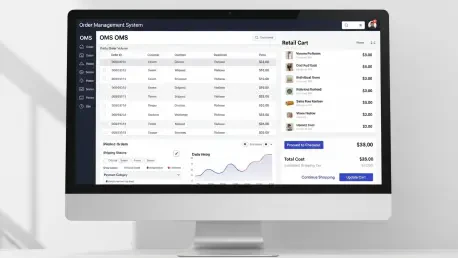Setting the Stage for Retail Transformation
In the fast-paced world of retail, where customer expectations for seamless shopping experiences soar higher each day, a staggering statistic emerges: over 70% of consumers demand consistent interactions across online and offline channels, and retailers who fail to meet this benchmark risk losing loyalty in an industry where every click and transaction counts. This pressing challenge underscores the critical role of technology in bridging operational gaps, particularly through sophisticated platforms designed to streamline order processes. Enter the Order Management System (OMS), a pivotal tool that promises to revolutionize how retailers manage their sprawling networks of sales channels in 2025.
The retail landscape today is defined by complexity, with customers expecting options like click-and-collect or same-day delivery as standard offerings. An OMS stands at the heart of this transformation, acting as a centralized hub to orchestrate orders, inventory, and fulfillment with precision. This review delves into the intricacies of OMS technology, evaluating its core features, performance benefits, and the broader implications for retailers striving to stay competitive in an omnichannel era.
Unpacking the Core Features of OMS Technology
Real-Time Inventory Visibility for Precision
One of the standout capabilities of an OMS is its ability to provide real-time inventory visibility across all sales channels. This feature ensures that stock levels remain accurate, preventing costly errors such as overstocking or unexpected stockouts. Retailers gain a unified view of their inventory, often referred to as a single source of truth, which enhances decision-making and minimizes disruptions in the supply chain.
Beyond mere tracking, this functionality plays a vital role in improving fulfillment accuracy. When a customer places an order, the system instantly identifies available stock at the nearest location, ensuring faster delivery and reducing the likelihood of unfulfilled promises. Such precision not only boosts operational reliability but also fosters trust with consumers who value transparency in product availability.
Automated Fulfillment for Operational Efficiency
Another cornerstone of OMS technology lies in its automation of fulfillment processes. By intelligently routing orders to the most optimal locations based on proximity, cost, and capacity, the system slashes shipping times and trims expenses. This dynamic allocation eliminates much of the guesswork that traditionally plagues manual order handling.
Automation also translates into tangible benefits for scalability. Retailers can handle spikes in demand—such as during holiday seasons—without overburdening staff or infrastructure. The reduction in manual intervention further cuts down on human error, ensuring that orders reach customers promptly and correctly, thereby elevating the overall shopping experience.
Seamless Integration with Sales Platforms
Integration capabilities form a critical pillar of OMS functionality, enabling compatibility with a wide array of e-commerce platforms and sales channels. This seamless synchronization of data ensures consistency whether a transaction occurs online, in-store, or via a third-party marketplace. Retailers benefit from a cohesive ecosystem where updates to inventory or order status reflect instantly across all touchpoints.
Such connectivity is indispensable for maintaining a unified brand presence in the eyes of customers. When discrepancies in stock or pricing are eliminated, trust in the retailer strengthens, paving the way for repeat business. This feature also supports rapid adaptation to new sales channels, allowing businesses to expand their reach without the headache of fragmented systems.
Performance Benefits and Industry Impact
Driving Omnichannel Excellence
The true power of an OMS shines in its ability to support omnichannel retail strategies. Features like ship-from-store, reserve-in-store, and click-and-collect become seamless operations under a robust system, meeting modern consumer demands for flexibility. Retailers can offer these services confidently, knowing that inventory and order data remain synchronized across all platforms.
This capability has proven transformative for industries ranging from fashion to electronics, where customer expectations for convenience are particularly high. Successful implementations by major retailers demonstrate how an OMS can turn logistical challenges into competitive advantages, unlocking new revenue streams through enhanced service offerings.
Cost Savings and Scalability Gains
From a financial perspective, the adoption of an OMS delivers substantial cost savings by optimizing fulfillment routes and minimizing manual labor. Retailers report reduced shipping expenses as orders are dispatched from the most efficient locations, while centralized systems cut down on administrative overhead. These efficiencies are crucial for maintaining slim margins in a cutthroat market.
Scalability stands out as another key benefit, with systems designed to grow alongside the business. Whether a retailer operates a handful of stores or a global network, the technology adapts to handle increased order volumes without compromising speed or accuracy. This flexibility ensures long-term viability in an industry prone to rapid shifts in demand.
Challenges in Adoption and Implementation
Navigating Integration Hurdles
Despite its many advantages, integrating an OMS with existing legacy systems often presents a significant challenge. Many retailers operate on outdated infrastructure that struggles to communicate with modern platforms, necessitating careful planning and sometimes costly overhauls. This barrier can delay deployment and strain budgets if not addressed strategically.
Data accuracy poses another hurdle, as inconsistencies between systems can undermine the reliability of the OMS. Ensuring that information flows smoothly requires meticulous attention to detail during setup and ongoing maintenance. Retailers must prioritize robust data governance to avoid pitfalls that could erode customer confidence.
Overcoming Resistance and Training Needs
Change management emerges as a critical factor in successful OMS adoption. Staff accustomed to traditional processes may resist the shift to automated systems, necessitating comprehensive training programs to ease the transition. Without proper education, the full potential of the technology remains untapped, limiting return on investment.
Additionally, the upfront costs of implementation can deter smaller retailers from embracing this technology. Vendors are increasingly offering scalable solutions and support services to mitigate this concern, but the initial financial commitment remains a consideration. Strategic partnerships and phased rollouts can help alleviate these pressures over time.
Reflecting on the OMS Journey and Next Steps
Looking back, the journey of Order Management Systems in reshaping retail operations has been marked by remarkable strides in efficiency and customer satisfaction. The technology has proven itself as a linchpin for omnichannel success, delivering on promises of real-time visibility, automated processes, and seamless integration. Retailers who embraced these systems have witnessed tangible improvements in their ability to meet consumer demands while optimizing costs.
Moving forward, the focus should shift to leveraging emerging innovations such as AI-driven forecasting and sustainable fulfillment practices. Retailers are encouraged to evaluate OMS solutions based on scalability and vendor support to ensure adaptability to future trends. Investing in staff training and robust data management will be essential to maximize benefits and maintain a competitive edge.
Ultimately, the path ahead lies in fostering a mindset of continuous improvement. Exploring partnerships with technology providers and staying attuned to evolving market dynamics will empower retailers to refine their operations further. The legacy of OMS as a transformative force in retail serves as a reminder that strategic adoption of such tools can redefine success in an ever-changing landscape.









